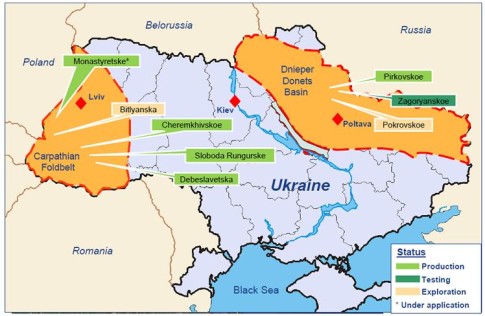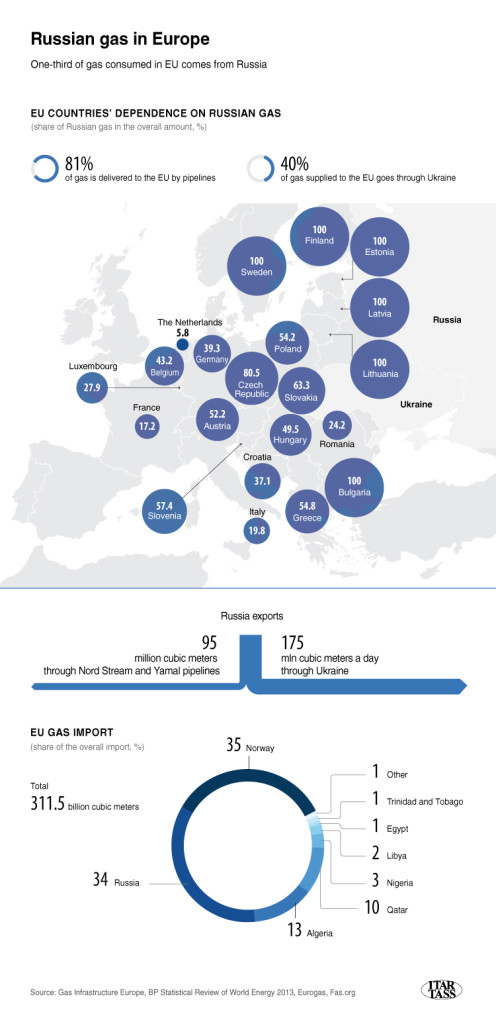– Gazprom To Europe: We Own You (At Least Until 2016) (ZeroHedge, Aug 14, 2014):
It is no secret that in scrambling to find an alternative to Russia’s energy-export dominance, Europe is actively seeking to recreate the US shale miracle (at least superficially, recall that a month ago Germany shelved shale-gas drilling plans until at least 2021, when it would again reassess the shale ban). Curiously, one of the few places that features as a most probable candidate for shale drilling, is none other than Ukraine itself whose Dnieper-Donets basin is a place targeted by local energy company Burisma, where as we have reported extensively in the past, none other than Joe Biden’s son, Hunter, has been strategically placed as a director to give the US a front line of sight into drilling developments.
There is one problem, however, and a rather major one at that: it will take Europe years, in a best case scenario at that, before it can bring its shale output online. In fact, according to Gazprom’s quarterly report released on Wednesday, shale gas production in Europe could be possible in Europe not earlier than in 2016-2018. Which, of course, is Gazprom’s polite way of saying that for at least the next two years, and likely far longer, European marginal gas needs will be met by the dreaded Russian semi-nationalized monopoly, which in turn means that for all the posturing, the Kremlin will have an exclusive “right of first refusal” to determine European economic growth with the literal push of a button.
“Commercial shale gas production in Europe can begin not earlier than in 2016-2018 even with positive geological surveys. But production volumes will not bring about major changes in the European gas market due to a decline in conventional gas production,” the report said.
Which, sadly for Europe, means that Putin will be dictating his terms on the energy-strapped continent for a long, long time.
Itar-Tass adds that while Great Britain is pinning hopes on its Bowland Basin, geological prospecting for shale gas there has so far failed to produce positive results and has been complicated by public protests and closeness to major cities such as Liverpool, Leeds and Manchester.
Shale gas production in Europe can also encounter certain problems such as the need to drill a large number of wells and use chemicals for boosting the inflow of gas, which may be difficult to do in densely populated Europe where environmental and water safety concerns are high on the agenda.
What other potential drilling locations are there? Not many, but one stands out: Ukraine.
France has prohibited the use of hydraulic fracturing technology for the production of shale gas in 2011. Germany, the Netherlands, France, and Bulgaria followed suit with complete bans or partial restrictions.
However, the governments of Poland, Britain and Ukraine have offered tax benefits in order to encourage shale gas production.
But Tatyana Timochko, the head of the Ukrainian Ecological League, warned that commercial shale gas production in Ukraine could cause irreparable damage to the environment. She said, citing findings by Ukrainian scientists from the National Academy of Sciences, that it would take an area of about two hectares to drill just one well.
According to the expert, this will mean stripping the area “down to clay” in order to get a stable solid surface for process equipment, whereupon “thousands of hectares of fertile land will be ruined irrecoverably.” “This technology [of underground hydraulic reservoir fracturing] requires 5,000 to 20,000 cubic metres of water mixed with chemicals to be pumped down to a depth of 3-5 kilometres, with only 20-25% of this water coming back to the surface afterwards,” she said.
After passing through radioactive rock, the water mixed with rocks, clay, sand and chemicals will come back to the surface, but it is not known how it will be recycled, Timochko said.
“This water will get back to the surface and then what? It’s nothing like the Marcellus Formation in America where the public forced [the authorities] to build a plant for recycling this mass only 15 years later. Until then it was dumped into the desert, into some pits there. But density [of population] there where the Marcellus Formation is, are 2 persons per square kilometre, while in the Kharkiv and Donetsk regions it is 78-84,” she said.
Timochko stressed that “there is simply no place to dump this solution” in Ukraine. “All this dirt will stay on the surface and will poison surface water,” she warned. She also spoke of possible consequences of shale gas production in areas where coal was or still is mined.
“Mines have already created manmade faults and if hydraulic fracturing starts, the degree of ground shaking will increase. These are manmade earthquakes that the British spoke of and that forces them to stop shale gas production in England,” Timochko said.
So yes, difficult, contested, unpopular. But quite feasible. All one needs, to quote Rahm Emanuel, is a “crisis.” Like the civil war currently above the Dnieper-Donetsk basin.
Which brings us back to what we wrote in the last week of July, namely that the “Company In Which Joe Biden’s Son Is Director Prepares To Drill Shale Gas In East Ukraine.”
There is only one problem: the shale drilling would have to be situated in the Donetsk Republic region, which just so happens… is currently blanketed by a civil war.
Which for all those confused, should lay out the big picture, read energy, interests of Ukraine, Europe as well as Russia in east Ukraine very, very clearly.
And while the map above is quite useful to understand the underlying motives behind Europe’s deadliest conflict in years, the one below is just as, if not more, relevant. If only for the next 2-4 years.

